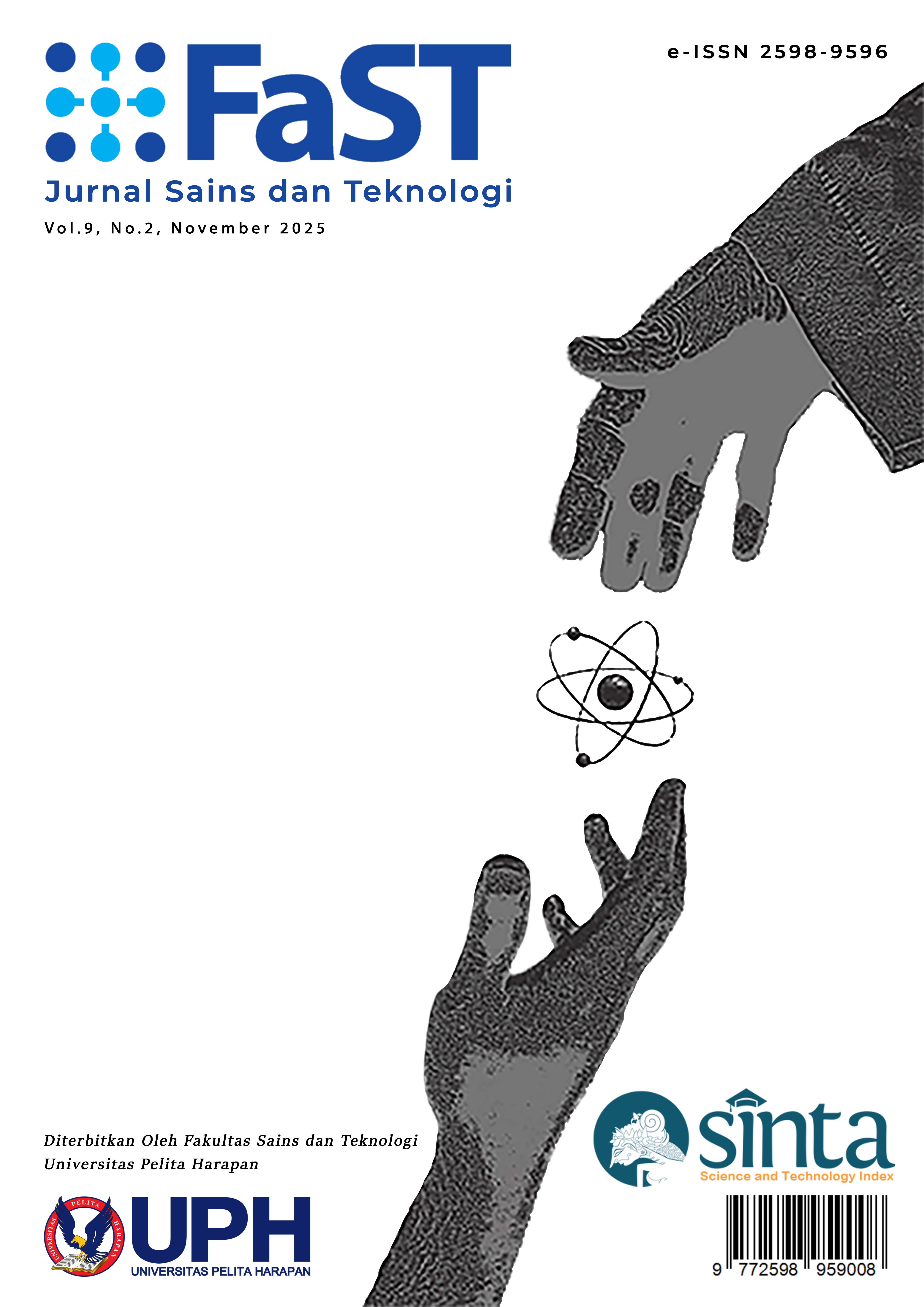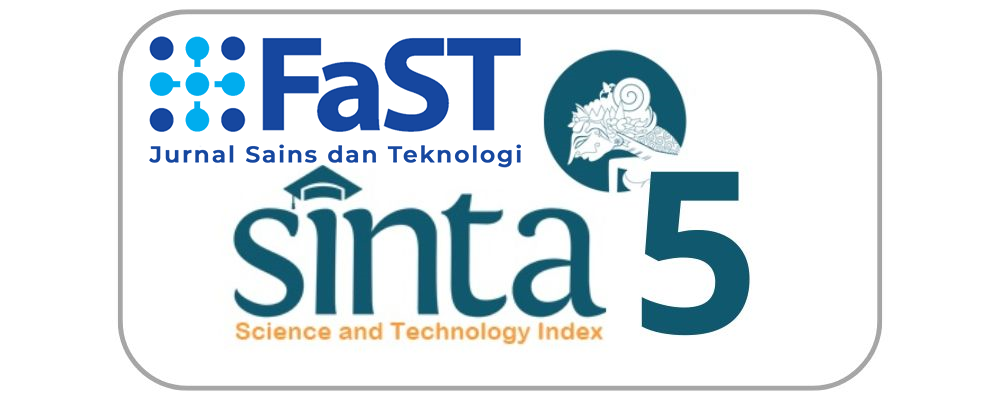Pengaruh Penambahan Ekstrak Kulit Buah Naga terhadap Karakteristik Fisikokimia, Aktivitas Antioksidan, dan Sensori Permen Jeli Glukomanan Konjak
[The Impact of Dragon Fruit Peel Extract Addition on The Physicochemical Properties, Antioxidant Activity, and Sensory Attributes of Konjac Glucomannan Jelly Candy]
DOI:
https://doi.org/10.19166/jstfast.v9i2.10389Keywords:
Jelly candy, Dragon Fruit Peel, Konjac Glucomannan, AntioxidantAbstract
Dragon fruit peel is an agro-industrial by-product rich in bioactive compounds such as flavonoids, anthocyanins, phenolics, thiamine, pyridoxine, cobalamin, and carotene, which exert various physiological health effects. This study aimed to evaluate the effect of dragon fruit peel extract on the physical, chemical, functional, and sensory characteristics of konjac glucomannan-based jelly candy. The research was conducted in two stages: (1) extraction and characterization of dragon fruit peel extract, and (2) formulation of jelly candy with four extract concentrations, namely T0 (0%), T1 (9%), T2 (10%), and T3 (11%). Data were analyzed using ANOVA followed by Duncan’s multiple range test. The extract contained alkaloids, flavonoids, tannins, and steroids, with total anthocyanin content of 77.57 mg/L and antioxidant activity of 46.3%. The best formulation was obtained at T3 (11%), which exhibited total anthocyanins of 27.55 mg/L, antioxidant activity (IC50) of 98.44 ppm, total dissolved solids of 60.63 0brix, hardness of 2.31 N, L* is -46,40, a* is 30,81, b* is 14,80, c* is 32,19, H* is 9,35, and an overall sensory acceptance score of 4.68 (neutral–like). The addition of up to 11% dragon fruit peel extract enhanced antioxidant activity of the jelly candy without negatively affecting consumer acceptance.
Bahasa Indonesia Abstract: Kulit buah naga merupakan hasil samping yang kaya akan senyawa bioaktif seperti flavonoid, antosianin, fenolik, tiamin, piridoksin, kobalamin, dan karoten yang memiliki efek fisiologis bagi kesehatan. Penelitian ini bertujuan untuk mengetahui pengaruh ekstrak kulit buah naga terhadap karakteristik fisik, kimia, fungsional, dan sensori permen jeli berbasis glukomanan konjak. Penelitian terdiri atas dua tahap, tahap 1 adalah ekstraksi dan karakterisasi ekstrak kulit buah naga, dan tahap 2 adalah formulasi permen jeli dengan empat perlakuan konsentrasi ekstrak kulit buah naga: T0 (0%), T1 (9%), T2 (10%), dan T3 (11%). Analisis yang dilakukan meliputi analisis fisik, analisis kimia, analisis fungsional, dan analisis sensori. Data dianalisis menggunakan ANOVA dan uji lanjut Duncan. Hasil penelitian menunjukkan bahwa ekstrak kulit buah naga mengandung alkaloid, flavonoid, tanin, dan steroid, dengan total antosianin 77,57 mg/L dan aktivitas antioksidan 46,3%. Formula terbaik diperoleh pada perlakuan T3 (11%) dengan total antosianin 27,55 mg/L, aktivitas antioksidan 38,28%, total gula 60,63%, kekerasan 2,31 N, L* sebesar -46,40, a* sebesar 30,81, b* sebesar 14,80, c* sebesar 32,19 dan H* sebesar 9,35, dan nilai penerimaan sensori keseluruhan 4,68 (kategori netral–suka). Penambahan ekstrak kulit buah naga hingga 11% meningkatkan kandungan senyawa bioaktif dan aktivitas antioksidan tanpa menurunkan penerimaan konsumen.
References
Alvita, R. L., Elsyana, V., & Kining, E. (2021). Formulasi Permen Jelly Jeruk Kalamansi Dengan Substitusi Glukomanan Konjak. Journal Of Nutrition And Culinary (JNC), Vol 1 No. 2, 1(2), 11–19. https://doi.org/10.24114/JNC.V1I2.26863
Aryanti, N., Kharis, D., & Abidin, Y. (2015). Ekstraksi Glukomanan dari Porang Lokal (Amorphophallus oncophyllus dan Amorphophallus muerelli blume). In METANA (Vol. 11, Issue 01). Universitas Diponegoro.
Bintoro, V. P., Dwiloka, B., Ekaputri H. L., Kamil, R. Z., (2024). The effect of gelatin and konjac glucomannan concentrations on moisture content, water activity, texture, density, and protein content in synbiotic marshmallows. Food Research 8 (4): 409 – 41. https://doi.org/10.26656/fr.2017.8(4).623
Choirunisa, R.F., Susilo, B., & Nugroho, W.A. (2014). Pengaruh Perendaman Natrium Bisulfat (NaHSO3) dan Suhu Pengeringan terhadap Kualitas Pati Umbi Ganyong (Canna Edulis Ker). Jurnal Bioproses Komoditas Tropis, 2(2), pp. 116–122.
Fang, Y. et al. (2023). Konjac Glucomannan: An Emerging Specialty Medical Food to Aid in the Treatment of Type 2 Diabetes Mellitus. Foods, 12(2), p. 363. https://doi.org/10.3390/foods12020363
Fitriana, T., Nurwantoro., & Susanti, S. (2020). Pengaruh Proporsi Kolang – Kaling Terhadap Karakteristik Fisik , Kimia dan Hedonik Permen Jelly Labu Kuning. J. Teknologi Pangan, 4(1), pp. 30–35. Available at: https://ejournal3.undip.ac.id/index.php/tekpangan/article/view/24037 (Accessed: 30 December 2022).
Hasanah, A., Nurrahman., & Suyanto, A. (2022). Penambahan Ekstrak Kulit Buah Naga terhadap Derajat Warna, Kadar Antosianin, Aktivitas Antioksidan dan Sifat Sensoris Cendol. Jurnal Pangan Dan Gizi, 12(1), 25–31. https://doi.org/10.26714/jpg.12.1.2022.25-31
Herawati, H., & Kamsiati, E. (2022). The Characteristics of Low Sugar Jelly Made From Porang Flour and Agar. IOP Conference Series: Earth and Environmental Science, 1024(1). https://doi.org/10.1088/1755-1315/1024/1/012019
Jawa La, E.O., Sawiji, R.T., & Yuliawati, A.N. (2020). Skrining Fitokimia Dan Analisis Kromatografi Lapis Tipis Ekstrak Etanol Kulit Buah Naga Merah (Hylocereus polyrhizus). Indonesian Journal of Pharmacy and Natural Product, 3(1), pp. 45–58. https://doi.org/10.35473/ijpnp.v3i1.503
Julyaningsih, A.H., Yuliana, I., & Binalopa, T. (2022). Penentuan Perlakuan Terbaik Formulasi Sari Buah Buni sebagai Minuman Fungsional Menggunakan Analytic Hierarchy Process. Dewantara Journal of Technology, 03(01), pp. 1–5. https://doi.org/10.59563/djtech.v3i1.143
Karismawati, A.S., Nurhasanah, N., & Widyaningsih, T.D. (2015). Pengaruh minuman fungsional jelly drink kulit buah naga merah dan rosella terhadap stres oksidatif [inpress april 2015]. Jurnal Pangan dan Agroindustri, 3(2), pp. 407–416. Available at: https://jpa.ub.ac.id/index.php/jpa/article/view/157 (Accessed: 23 February 2023).
Maryam, A., Dian Sari., & Barat, K. (2021). Formulasi permen jelly sari buah jeruk siam. Jurnal Agercolere, 3(2), 57–62. https://doi.org/10.37195/jac.v3i2.132
Nilawati, N.K., Suriani, M., & Panti, R. (2019). Pemanfaatan kulit buah naga menjadi permen jelly kering. Jurnal Bosaparis: Pendidikan Kesejahteraan Keluarga, 10(2), p. 95. https://doi.org/10.23887/jjpkk.v10i2.22133
Noviyanty, A., Salingkat, C.A., & Syamsiar, S. (2019). Pengaruh jenis pelarut terhadap ekstraksi dari kulit buah naga merah (hylocereus polyrhizus). Kovalen: Jurnal Riset Kimia, 5(3), pp. 271–279. https://doi.org/10.22487/kovalen.2019.v5.i3.14037
Onsamlee, G., and Srikok, S. (2022). Use of Konjac Powder in Mulberry Jelly Gummy Products, RMUTI Journal, vol. 15, no. 3, pp. 107–120, Dec. 2022.
Pérez, S. M. (2021). Physicochemical Characterization of Pomegranate (Punica Granatum L.) Native to Jordan During Different Maturity Stages: Color Evaluation Using the Cielab and Cielch Systems. Journal of Ecological Engineering, 22(6), 214–221. https://doi.org/10.12911/22998993/137440
Permatasari, N.A., & Yusma Deofsila, K. (2021). Perubahan Kualitas Bubuk Pewarna Alami Buah Buni (Antidesma Bunius (L) Spreng) Selama Penyimpanan dengan Menggunakan Metode Akselerasi. Jurnal Teknologi Industri Pertanian, 31(2), pp. 176–189. https://doi.org/10.24961/j.tek.ind.pert.2021.31.2.176
Prabowo, I. et al. (2019). Characteristics and antioxidant activities of anthocyanin fraction in red dragon fruit peels (Hylocereus polyrhizus) extract. Drug Invention Today, 12(4), pp. 670–678. Available at: https://futuresciencepress.com/public/storage/CJ871.pdf (Accessed: 23 February 2023).
Putra, Y. A., Putra Mahardika, M., Ayu, D., & Permatasari, I. (2021). Uji aktivitas antioksidan fraksi kloroform-fraksi etil asetat-fraksi air kulit buah naga merah (hylocereus polyrhizus) dengan metode DPPH (1,1-Diphenyl-2-Picrylhydrazyl). Jurnal Farmasi Dan Kesehatan Indonesia, 1(2), 40–53. http://journal.ukrim.ac.id/index.php/jfki/article/view/243
Sari, S. S., Nurrahman, & Nurhidajah. (2021a). Pemanfaatan Sari Kulit Buah Naga sebagai Upaya Peningkatan Nilai Fisik dan Sensori pada Permen Jelly Sari Tempe. Jurnal Pangan Dan Gizi, 11(01), 60–72.
Siwi, A. N., Luthfhianto, D., & Wardana, A. S. (2019). Pengaruh pewarna kulit buah naga merah terhadap potensi antioksidan, warna dan sensoris permen jelly jagung (Zea mays. L). Jurnal BisTek pertanian: Agribisnis Dan Teknologi Hasil Pertanian, 01(08), 150–263. https://doi.org/10.37832/bistek.v6i01.8
Susanti, L. H., Pratama, Y., Nurwantoro, N. (2017). Preferensi Konsumen terhadap Bakso Analog Tepung Kacang Koro Pedang dengan Penambahan Tepung Maizena sebagai Bahan Pengikat. Jurnal Teknologi Pangan;, 1(2), 28–32. https://doi.org/10.14710/jtp.v1i2.17290
Tarahi, M., et al. (2023). Current Innovations in the Development of Functional Gummies Candies. Foods 2024, 13(1), 76; https://doi.org/10.3390/foods13010076
Teixeira-Lemos, E., Almeida, A.R., Vouga, B., Morais, C., Correia, I., Pereira, P., & Guiné, R.P.F. (2021). Development and characterization of healthy gummy jellies containing natural fruits. Open Agriculture, 6(1), 466–478. https://doi.org/10.1515/opag-2021-0029
Yuda, P. E. S. K., Cahyaningsih, E., Winariyanthi, N. P. Y. (2017). Skrining fitokimia dan analisis kromatografi lapis tipis ekstrak tanaman patikan kebo (Euphorbia hirta L.). Jurnal Ilmiah Medicamento, 3(2), 61–70. https://doi.org/10.36733/medicamento.v3i2.891
Zhang, H. et al. (2024). Enhanced stability and bioavailability of mulberry anthocyanins through the development of sodium caseinate-konjac glucomannan nanoparticles. Food Chem 439:138150. https://doi.org/10.1016/j.foodchem.2023.138150
Downloads
Published
Issue
Section
License
Copyright (c) 2025 Wiwit Amrinola, Hanandhiya

This work is licensed under a Creative Commons Attribution-ShareAlike 4.0 International License.
“Authors who publish with this journal agree to the following terms:
1) Authors retain copyright and grant the journal right of first publication with the work simultaneously licensed under a Creative Commons Attribution License (CC-BY-SA 4.0) that allows others to share the work with an acknowledgement of the work's authorship and initial publication in this journal.
2) Authors are able to enter into separate, additional contractual arrangements for the non-exclusive distribution of the journal's published version of the work (e.g., post it to an institutional repository or publish it in a book), with an acknowledgement of its initial publication in this journal.
3) Authors are permitted and encouraged to post their work online (e.g., in institutional repositories or on their website). The final published PDF should be used and bibliographic details that credit the publication in this journal should be included.”



